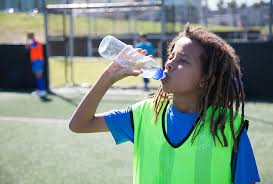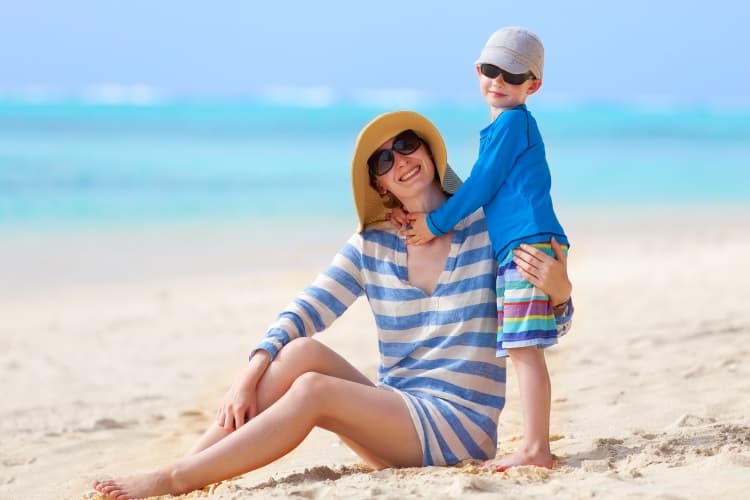Here are 7 Risks Kids Face From the Sun “Just Because they are Kids.”

Have you taught your kids about these 7 risks kids face just because they are kids?
Starting with sunburn, heat exhaustion, sunstroke, dehydration, skin cancer, long-lasting skin damage leading to early aging, and sun allergies.
The risk for sunburn is high in kids, just because they are kids.
1. Sunburn Risk is High for Kids, Just Because they are Kids
Sunburn for kids is a high risk as they have immature skin. Our dermatologist tells us that kids’ skin isn’t fully mature until late teens or early twenties.
When they are exposed to the sun, they are endangering their newly forming skin layers. This is why so many adults have skin cancer. They were exposed to the sun too early in life. Remember, from birth to 6 months, only indirect light of any kind.
Kids need time for their skin to mature safely. This doesn’t mean not getting out earlier or later. Just avoid the direct sun from 10 AM until 4 PM if you live where there is lots of sunshine as we always have.
If your child is in the sun too long or overexposed to the sun, sunburn can set in fast. Even if your family’s skin tones are darker than my family, you should not have your kids out in the direct sun. Damage does not always completely heel. and if it does heal, some of the DNA may have been destroyed.
A sunburn for your kids can lead to pain, blistering, and peeling skin. And if it is a more severe sunburn, raised temperatures, headaches, and nausea. This means an emergency room visit for your kid. There may be other issues combined with these normal sunburn symptoms.
Safety Measures You Can Take
These sunburns are preventable. Making sure your kids are avoiding the most dangerous time of day to be out is a giant step. Yes, you can sunburn in the earlier sun or the later sun. However, it will take longer, and you have time to notice a flushed face or a skin rash.
My skin will start flushing after 20 minutes in the direct sun, how long does it take yours? Your kids will probably reach to start of a sunburn or a flush in less time than you will, while their young skin is still maturing.
The sunburn symptoms for kids get dangerous quickly. Besides the pain and discomfort, sleep can be affected. Then there is skin blistering, and peeling which can result in infection. Kids have trouble resisting the urge to scratch an itchy area of their skin.
Covering your kids with a shirt that will block the sun from the trunk of their body is a start. Choose a tightly woven fabric that fits loosely.
Repeated sunburn, while a child is young, can cause long-term damage to their skin’s ability to heal properly. If your child is getting repeated sunburn damage, this indicates a family lifestyle that is dangerous. Changing some habits now will enable your kids to have healthier skin.
Sami’s Suggestions For Safe Sun Habits
Schedule safe times for outdoor play every day. Before 10 AM and after 4 PM. Wearing sun blocking clothing when the kids are outside will protect them from accumulating too much sun on their skin. A long-sleeve sun-blocking shirt that is made of tightly woven fabric, a sun blocking hat, and sunglasses are where you start. Keeping skin covered is a giant safety step.
Make sure your kids are spending some of their outdoor time in the shade. Umbrellas, pop-ups, any kind of state to allow their skin to cool down and rest from the direct sun, even early or late.
Wet clothing loses a lot of its ability to block the sun. Kids that are in and out of the pool all day will need shade to dry their clothing, and prevent the sun from shining through to their skin.
Often it may seem too expensive to have UPF-rated clothing for everyday for kids. Here is a hack to make sure their regular clothing from the closet is protecting their skin,. Maybe not as much as an officially rated garment, but some protection from the sun.

2. Heat Exhaustion Risk For Kids
Heat exhaustion is another potential risk for kids. They are still young and developing their skin. Normally our skin surface draws out the heat to allow our bodies to cool themselves and keep our body temperature at a safe level to maintain body functions.
However, youngsters don’t always realize that it is time to sit down and cool down. Their skin isn’t efficient yet. It is developing, just not there yet. Little ones can increase their body temperature just by crying. When they are running and playing they just don’t yet recognize they should do something about their body heat.
Young kids playing early sports don’t realize they need to take a break and cool down. Often they are trying so hard to do what the older kids are doing that they get too hot. Their bodies can’t cool off quickly enough, and with sports, there are often uniforms and equipment that also slow body cooling.
Heat Exhaustion is the first step toward heat stroke. It can include headaches or nausea, dizziness, muscle cramps, and weakness. As their bodies are sweating trying to cool down, there can be a loss of fluids and electrolytes.
Heat exhaustion can lead to heat stroke. Pay attention to the kids as they are playing. Maybe a drink of water and a short break is what is needed.
If left untreated, heat exhaustion can progress to heat stroke, which is a life-threatening medical emergency.
Sami’s Suggestions for Preventing Heat Exhaustion for your Kids
Preventing heat exhaustion involves taking measures to stay cool and hydrated.
Children should wear lightweight, breathable clothing and hats to protect them from the sun. There should also be frequent breaks in shaded or air-conditioned areas.
It’s also important to encourage your kids to drink plenty of fluids. And they need to drink fluids even if they don’t feel thirsty.
Avoid sugary or caffeinated drinks that can worsen dehydration.
If your kid shows signs of heat exhaustion, it’s important to move him/her to a cool place. Encourage them to drink fluids.
This last suggestion is very important. Seek medical attention if their symptoms don’t improve.

3. Your Kid’s Risk For Heat Stroke
A heat stroke, also called a sunstroke, is a serious medical condition.
If your child’s body’s internal temperature cooling system lags behind or fails leading to a quick increase in body temperature.
Heat stroke is dangerous for young kids because their bodies just aren’t as efficient yet at regulating their internal temperature. They are not mature yet.
Because they are still young, they may not be able to meet the need to cool their body’s internal temperature, yet. Even if they are not in the direct sun, if they get too warm, their body may not be able to cool fast enough. This is what puts young ones at risk during a heat wave.
Then when you add heat from playing in the direct sun the stress on their cooling ability is high. Sun stroke, or heat stroke are very real dangers.
Young children have a greater surface area-to-body mass ratio than adults, which means that they absorb heat more easily from their environment.
Journal of Applied Physiology reported on a study that compared the heat exchange rates between children and adults during exercise.
The researchers found that the children had a higher core temperature and sweat rate than the adults. This means that they absorb heat more easily from their environment.
Another study published in the Journal of Pediatrics analyzed the effects of average body temperature on infants and young children. The results: Infants and young children are more sensitive to changes in the average temperature than adults. Their body temperature can increase more rapidly in a warm environment.
Furthermore, the American Academy of Pediatrics suggests that we as parents and caregivers be extra careful to protect our children from heat-related illnesses during hot weather.
We can do this by providing plenty of fluids and avoiding prolonged exposure to the sun.
Heat Stroke is a Serious Condition for Kids
Kids have immature sweating mechanisms, plus the inability to effectively communicate their discomfort can make it difficult for parents or caregivers to recognize the early signs of heat exhaustion.
This delay in identifying and treating heat exhaustion can increase the likelihood of the child progressing to heat stroke, which can cause serious organ damage or even death.
Internal damage can occur for young kids because their bodies are still developing. This makes them vulnerable to the effects of dehydration and electrolyte imbalances.
Prolonged exposure to high temperatures can lead to significant fluid loss and electrolyte imbalances This makes it more difficult for younger kids to recover,. In severe cases, this can lead to kidney damage, seizures, and even coma.
Finally, young children, are often more active and less aware of their surroundings than adults.
This can lead to prolonged exposure to direct sunlight or hot environments, which can increase the effects of heat exhaustion.
Parents and caregivers should be aware of the risks of sunstroke in young children and take steps to prevent it. Help kids stay hydrated, and avoid direct sunlight during the hottest parts of the day. Don’t forget to take frequent breaks in cooler, shaded areas.
4. Dehydration Risks For Kids
Playing outside in the sun, is the perfect opportunity for kids to become dehydrated. They are playing and probably sweating, and don’t take time to get a drink. Young kids, even teens may not recognize the signals for being thirsty.
Dehydration is a dangerous risk for kids, just because they are kids. Sunburn and heat stroke are examples of issues when kids are easily dehydrated.
Your youngster will experience dehydration when losing more fluids than they are taking in. The heat that sunburn produces in the body requires more fluids. This is how the body usually cools itself. Circulating the heated blood deep in their bodies for cooling at the surface of their skin.
If there is damage to their skin that interferes with this process as in sunburn the cooling doesn’t happen as it should. Too tight clothing and even sports gear can also interfere with this necessary cooling process.
Dehydration Problems for Kids
Dehydration can lead to several problems for kids.
- Dehydration: This can cause fatigue, weakness, and dizziness for kids. These symptoms can make it difficult for kids to carry out normal routines, like playing and learning. If the case is severe, dehydration can lead to confusion, irritability, and even seizures. Yes, these are similar to what adults experience. The difference, your kids usually don’t know to tell you or get water for themselves.
2. Even little dehydration can affect a child’s physical performance and endurance. This can make them more susceptible to injuries and accidents. Your child may be more clumsy or move slower. This is especially noticeable when playing sports or engaging in physical activities.
3. Heat exhaustion or heat stroke is usually accompanied by dehydration. Pay attention, both are serious medical conditions that require immediate attention.
These reasons are why it is important to encourage kids to become aware of their need for plenty of water and fluids anytime they are out in the sun.
And this is important, especially during hot weather or physical activities. Preventing dehydration and its associated problems is better than recovering from any of them.
5. Allergies Are a Risk for Kids When Playing in the Sun
Do your kids have allergic reactions? Some kids may be allergic to the sun, causing them to break out in hives or rashes when exposed to sunlight.
As a parent, it’s important to be aware that some children can have an allergic reaction to the sun.
This condition is known as photosensitivity or sun allergy. If your child has this condition, they usually develop hives or a rash on their skin when they are exposed to sunlight.
For some kids, symptoms of a sun allergy can vary but may include redness, itching, and blistering. These reactions can be mild to severe. In some cases, the reaction may be more severe and cause swelling or even cause difficulty breathing.
It’s important to limit your child’s exposure to sunlight. The peak hours when the sun is strongest can be the most problematic.
Keeping your kids covered with clothing, especially UPF clothing. Remember their sun hats and sunglasses. Sunscreen on areas of their skin not covered.
If your kid experiences the symptoms of a sun allergy, get medical attention right away. A healthcare provider can diagnose the condition and recommend appropriate treatment, such as antihistamines or creams called topical steroids. Find out what your best options are.
It is important to be aware of the signs and symptoms of a sun allergy. When you take steps to protect your kid from the harmful effects of the sun, you are learning to live safely with the sun. Your kid’s healthy skin is worth the effort.
6. Sun Related Skin Damage
Kids and sun exposure on unprotected skin results in long-term damage to their skin.
Early skin damage sets your kid up for skin issues because the skin does not always heal properly. It can start with dry spots on their skin, resulting in more sensitivity to the sun. Sunburn on young immature skin can happen quickly. This is why it is important to cover and protect their skin.
Skin damage: Kids who get too much sun exposure without proper protection can suffer long-term damage to their skin, including premature aging, sunspots, and even skin cancer.
Remember those pictures of kids playing in the sun without shirts? Yes, we now know that those kids have a high risk of skin cancer as adults.
Your kids don’t care about premature aging. You have to care for them. This is when the foundation is set for early sun damage to their skin. They will run the risk of looking older than they are. Do they care? No, they don’t. But skin that is rough, wrinkled, and saggy will not be something they are proud of as they get older.
Help your kids have safe sun habits. Help them have comfortable sun blocking shirts, sun hats, and sunglasses. Keep them in, out of the sun during the hotter midday hours.
7. Skin Cancer Risks for Kids
When kids experience sunburns every summer, especially before they are 18 years old are at increased risk for skin cancer when they get older.
Melanoma is the deadliest form of skin cancer, and it can develop quickly and spread to other parts of the body. It is deadly because you can’t see it.
When you have darker skin tones, you may be careless about time in the sun because your damage doesn’t show up quickly. Cover your skin, and decrease your skin cancer risk.
Even if your kid is not wearing UPF-rated clothing, choose the best protective clothing he has and help him learn to leave it on in the sun.
Parents and caregivers must watch for signs of skin damage in children. Any changes in skin texture or color, new or changing moles, and persistent dryness or itching.
Encourage your kids to wear protective clothing, like sun hats, and long-sleeved loose-fitting shirts. They need to know about how to apply sunscreen regularly when spending time outdoors.
They should also know about reapplying sunscreen. If you have a pool at your house, help your kids reapply their sunscreen every two hours, or more often.
It’s also important to limit sun exposure during peak hours, between 10 AM and 4 PM when the sun’s rays are strongest. Early and later outside times are safer.
Sami’s Take On 7 Risks Kids Face from the Sun “Just Because They Are Kids.”
There is one more risk, that parents need to keep in mind that can make their kids at higher risk for sun damage. Medication
Check the labels of the medications your kids need. Make sure they are not on the list to raise your kid’s risks.
List of drugs for young kids’ parents:
- Antihistamines: These are medicines that help with allergies and allergic reactions.
- Coal Tar and Derivatives: These are medicines that treat skin conditions such as eczema and psoriasis.
- Contraceptives, Oral, and Estrogens: Medicines used to prevent pregnancy and treat certain medical conditions.
- Non-steroidal Anti-Inflammatory Drugs: These are medicines used to relieve pain and reduce inflammation, but should only be given under the supervision of a doctor.
- Phenothiazines: These are medicines used to treat mental health conditions such as schizophrenia.
- Psoralens: These are medicines used to treat skin conditions such as vitiligo.
- Sulfonamides: These are antibiotics used to treat bacterial infections.
- Sulfonylureas: These are medicines used to treat diabetes.
- Thiazide Diuretics: These are medicines used to treat high blood pressure and heart failure.
- Tetracyclines: These are antibiotics used to treat bacterial infections.
- Tricyclic Antidepressants: These are medicines used to treat depression, but should only be given under the supervision of a doctor.
It’s important to always consult with a healthcare professional before giving any medication to your child, as they can advise you on the proper dosage and potential side effects.
Thank you,
Sami
Source:
https://journals.physiology.org/
skincancer.org
DEA.gov